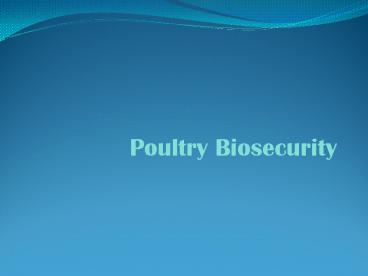Poultry Biosecurity - PowerPoint PPT Presentation
1 / 16
Title:
Poultry Biosecurity
Description:
Poultry Biosecurity * * * What is Biosecurity? Biosecurity: Addresses measures that should be taken to keep any diseases from a farm. Reduces the transmission of ... – PowerPoint PPT presentation
Number of Views:4375
Avg rating:3.0/5.0
Title: Poultry Biosecurity
1
- Poultry Biosecurity
2
What is Biosecurity?
- Biosecurity
- Addresses measures that should be taken to keep
any diseases from a farm. - Reduces the transmission of diseases to
neighboring farms. - Biosecurity reduces the risk of pathogens from
forming, which prevents the spread of diseases
from one flock to another.
3
What are Pathogens?
- Pathogens may be characterized as
- Bacteria single-celled organisms that are known
to cause infections. - Viruses tiny microscopic infectious agents that
replicate within the cells of living host. - Fungi organisms that live by breaking down and
absorbing the organic material in which they
grow. - Parasites organisms that live on or within a
host from which it obtains the nutrients it needs
to survive.
4
What are Diseases?
- A disease is
- any abnormal condition that impairs bodily
functions in an organism. - Diseases can be characterized by specific
symptoms and signs. - A disease may be caused by
- external factors (infectious disease)
- internal dysfunctions (autoimmune disease)
5
Why Does the Industry Use Biosecurity?
- Biosecuritys purpose in the industry is to
- Reduce the exposure of diseases and pathogens to
birds within a particular flock. - Reduce transmission of diseases and pathogens to
a neighboring farm. - Reduce the transmission of zoonotic diseases
- Infectious diseases that can be transmitted from
animals to humans or humans to animals.
6
Zoonotic Diseases
- Common Zoonotic Diseases
- Salmonella
- A bacteria transmitted between birds primarily
through the air. - The bacteria is shed from the infected bird
through feces, feather dust, and secretions made
from both the eyes and nose. - E. Coli
- A bacteria commonly found in the intestine of
birds. - The bacteria is harmless as long as it is kept in
check by other bacteria in the intestine.
7
What Are the Economic Benefits of Biosecurity?
- By reducing diseases and pathogens
- The producer saves money by not having to
euthanize (kill painlessly) all the birds in the
infected flock. - Depending on the size of the flock, the economic
loss could be worth millions of dollars.
8
How is Biosecurity Achieved?
- Tire Baths
- Reduces opportunity for incoming traffic, such as
feed and delivery trucks, to bring in pathogens
from outside the perimeter of the farm.
9
How is Biosecurity Achieved?
- Outside Perimeter
- High fences prevent intruders such as animals and
people from entering the premises and possibly
transmitting diseases to the flock.
10
How is Biosecurity Achieved?
- Footbaths
- Footbaths are placed outside the door of all
facilities and contain disinfectants, reducing
the risk of bringing pathogens inside the
buildings.
11
How is Biosecurity Achieved?
- Sanitation of Equipment and Supplies
- The purpose of sanitizing equipment, surfaces,
and supplies is to reduce pathogens. - This is especially important in preventing the
spread of diseases between neighboring flocks.
12
How is Biosecurity Achieved?
- Good Hygiene
- Prior to entering the facility, employees and
visitors should demonstrate good hygiene by
showering and wearing clean designated clothing
such as boot covers, hairnets, and cover-alls.
13
How is Biosecurity Achieved?
- Entrance Order
- The order of entering facilities depends on the
age of the birds. - For example, you want to enter the hatchery first
(where the youngest birds are), before entering
the grower house (where the older birds live.) - Older birds have stronger immune systems, making
them more resilient to any pathogens that may be
present.
14
How is Biosecurity Achieved?
- Hostile Environment
- Creating an environment that is non-desirable
will reduce the risk of transferring pathogens
from infected wild life. - Eliminating any trees, grass, and ponds from the
property will deter wildlife from trying to enter.
15
How is Biosecurity Achieved?
- Bait Stations
- Reduces the risk of rodents, which are small
enough to easily get into facilities and carry
many pathogens, from infecting the flock.
16
How is Biosecurity Achieved?
- No contact with outside birds
- Since most avian diseases are transmitted through
the air, it is highly important to have no
contact with outside birds within 72 hours of
entering a facility. - This includes pets as well as birds from other
flocks.

